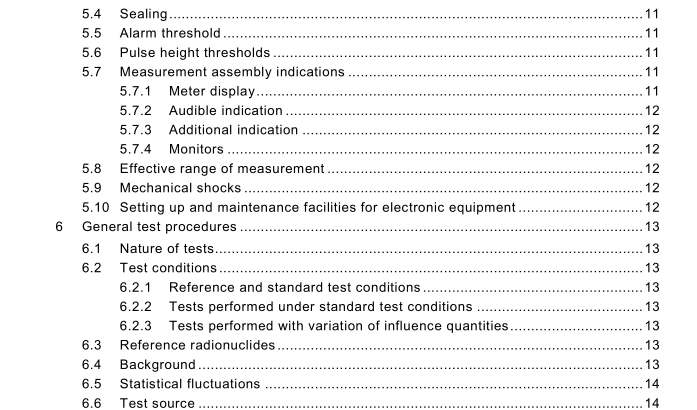BS IEC-62363:2008 pdf download – Radiation protection instrumentation — Portable photon contamination meters and monitors
4 Units In this standard, the units are the multiples and sub-multiples of units of the International System of Units (SI). The following non-SI units are also used: Time: years, days, hours (h), minutes (min). For energy: electron-volt (eV) (1eV = 1,602×10 –19 J).
NOTE Definitions of the radiation quantities and dosimetric terms are given in IEC 60050-393 and IEC 60050-394.
5 General characteristics
5.1 Classification The manufacturer shall classify the assembly according to the following photon energy range or ranges for which it is designed: Greater than 50 keV Between 20 keV and 50 keV Less than 10 keV
5.2 Detection assemblies The dimensions of the sensitive volume of the detection assembly shall be stated. For assemblies designed to measure low energy photons, the manufacturer shall also state the area of the detection window.
5.3 Ease of decontamination The assembly shall be constructed so as to permit easy decontamination. It is recommended that it be provided, for example, with a smooth non-porous external surface which is free from crevices. Alternatively, it shall be possible to use at least the measurement assembly when placed in a thin flexible envelope which is either disposable or easy to decontaminate and which is provided with transparent parts to permit the instrument scale to be read.
5.4 Sealing For assemblies intended for outdoor use, the manufacturer shall state the precautions that have been taken to prevent the ingress of moisture.
5.5 Alarm threshold This clause is applicable to monitors only. A monitor shall include circuits necessary for activating an alarm at one or more thresholds. The number of tripping levels shall be subject to agreement between manufacturer and purchaser. The values of alarm threshold shall be given either as percentages of the ranges or in terms of units of the display. Each alarm threshold shall be designed to allow convenient operational verification by means of test signals, radioactive sources or signal input circuitry. The range of adjustment shall be specified and the value of the alarm threshold shall be capable of being adjusted to any point within this range. It shall not be possible to incapacitate the alarm by any means such as setting the alarm thresholds beyond range limits. If a mute facility is provided it shall automatically reset when the alarm condition ceases. Alarm threshold adjustments shall not be easily accessible to the operator (for example keyswitch operated or protected password).
5.6 Pulse height thresholds Measurement assemblies should have the facility to set pulse height thresholds, which correspond to photon energy thresholds, in order to discriminate against interfering photon and/or beta radiations. Thresholds should be secure and only changed through internal controls or menus accessed by means of a password.
5.7 Measurement assembly indications
5.7.1 Meter display The assembly should display the count rate. Displays where the quantity displayed is derived from count rate such as activity should only be used where the radionuclide mix has been characterised. In this situation, the measurement assembly shall be programmed with the relationship between the surface emission rate and total activity (or activity per unit area) of the mix, taking account of the decay efficiency of the radionuclide(s), the surface emission rate response and the source efficiency. The manufacturer shall state the method used to program the assembly with this relationship. Where the assembly indicates activity, the manufacturer should indicate the assumed surface area of the activity. The unit of activity shall be the Becquerel (Bq).
For digital displays, an additional pseudo-analogue graphical indication should be provided which shows the count rate (or activity) in terms of the proportion of the maximum of the range indication, for example a bargraph. Where an instrument has a digital display, a feature shall be provided to check that all segments of the display are operational.
